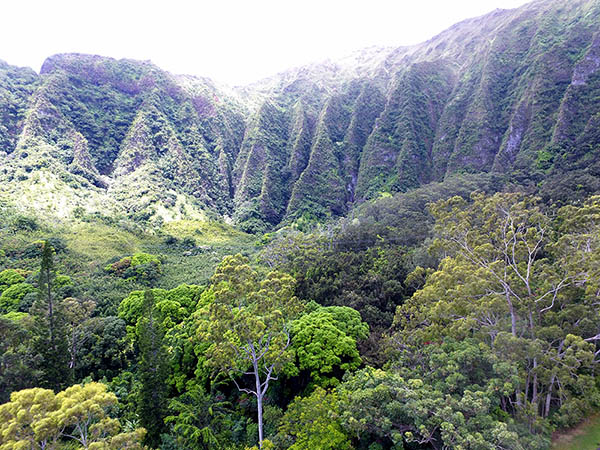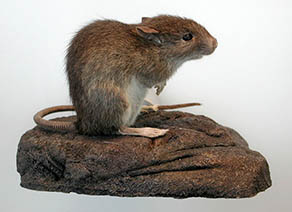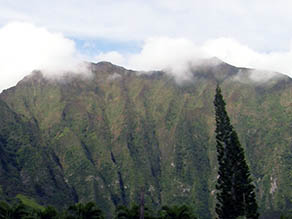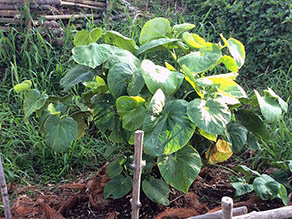 |
 |
 |
 |
||||||
|
|
|
|
|
|
|
|
|
|
 |
|
 |
 |

“At the top of the mountain there’s a plateau right below the ridge,” Mahealani tells us, “and that’s where they talk about the rolling rats of ‘Ioleka‘a. That’s what the name means: ‘rolling rats.’ We had the kama‘āina rats and that lived on the Ko‘olau side and we had the malihini [visitor] rats who lived on the Hālawa side. Hālawa is in the ‘Ewa moku. 
“The malihini rats were very obnoxious. They taunted and teased the kama‘āina rats a lot, and the kama‘āina rats did not appreciate that. They didn’t like them, so they hatched a plan. At the base of that platform where they all lived up near at the top of the pali, at the base of the platform is pool of water. And right below the platform is a little ledge. They hatched the plant to trick the malihini rats into chasing them. And they would trick them into falling into the pool. “So one day they started calling out names and taunting the malihini rats, throwing sticks and stones over the ridge to get the malihini rats to chase them. Finally the malihini rats came running over the ridge and chased after the kama‘āina rats who were on that platform. When they saw them coming, the kama‘āina rats jumped over the cliff and landed on the little ledge that they knew was below there. "But the malihini rats didn’t know about the ledge so they went running off the cliff chasing after the kama‘āina rats and went rolling and tumbling down into the pool where they drowned. That’s the story of ‘Ioleka‘a and the rolling rats of Ko‘olau.”
“Land called ‘Ioleka‘a, 'rolling rat,' mountain side of He‘eia. At the foot of the perpendicular pali is a small pool of water. It is here that the old natives tell this story: “For many, many years the kama‘āina rats of He‘eia have had a feud with the rats from other sections. From ‘Ewa and Honolulu and Waialua the malihini rats frequently follow a trail which leads up the ridge and over the range near Kaiwipo‘o to the palis overlooking He‘eia. Here the strangers meet the kama‘āina rats, who in a friendly and gracious manner offer to lead them down the steep trail, for on the He‘eia side the range rises almost perpendicularly from the land and the path is dangerous. "The kama‘āina leads the malihini over the difficult path until they are about halfway down the pali. Then they come to a rock, green with moss and wet from the water which seeps out. ‘This is not dangerous,’ says the kama‘āina and with the malihini he steps onto the slippery surface. With a quick jump to the side the kama‘āina rat catches himself on a small ledge, but the poor malihini rat slips and slides over the steep pali, and is knocked and rolled to the foot, where he falls insensible into the small pool of water. “You can always tell the malihini rats froin the kama aina, for the rats of He‘eia have red feet; and all the rats that drown in the pool have feet that are black or white, any color but red.”
“‘Ioleka‘a, is a place in Ko‘olaupoko. If the feet of a rat was red, it came from ‘Ewa, but if white, it came from Ko‘olaupoko. ‘Ioleka‘a was a supernatural rat that belonged to ‘Ewa. He fought against Maka‘iole-nana-wai, Ko‘olaupoko's rat. The ‘Ewa rat had such a long way to go and was weary before he started to fight. He was defeated and rolled down the hill. If you go to the pool there, you will find a stone rat with red feet.”
“They (Pikoi and others) sailed outside of Kaoio Point, between Kualoa and Ka‘a‘awa, he said, ‘Say there is a big rat on that hill.’ ‘How can you see that rat? You are lying, little boy.’ ‘There is a rat and it has nibbled on the roots of the ‘awa, and is drunk. He has rolled in some taro peeling. With one with my arrow, he will be killed.... If you see it send some men ashore to see it there above hill. The rat is there.... "One of the canoe paddlers went ashore and ran as far as He‘eia. Pikoiakaala shot the rat and said, ‘The rat is struck on the nose and the arrow has gone through it. The point of the arrow has lodged in a stone on the base of the cliff .... When the man who went ashore reached the place pointed out to him, he saw the rat shot through the nose... The spot was called ‘Iole-ka‘a (rolling-rat) because the rat rolled and lodged on a ledge of the cliff. This place bears the name of ‘Iole-ka‘a to this day.”
|
 |
|
 |
Across Ha‘ikū valley from ‘Ioleka‘a is another storied place, Keahiakahoe.
|
 |
||
 |
|
 |
||

|
 |
||||
|
||||
Copyright 2019 Pacific Worlds & Associates • Usage Policy • Webmaster |
||||


